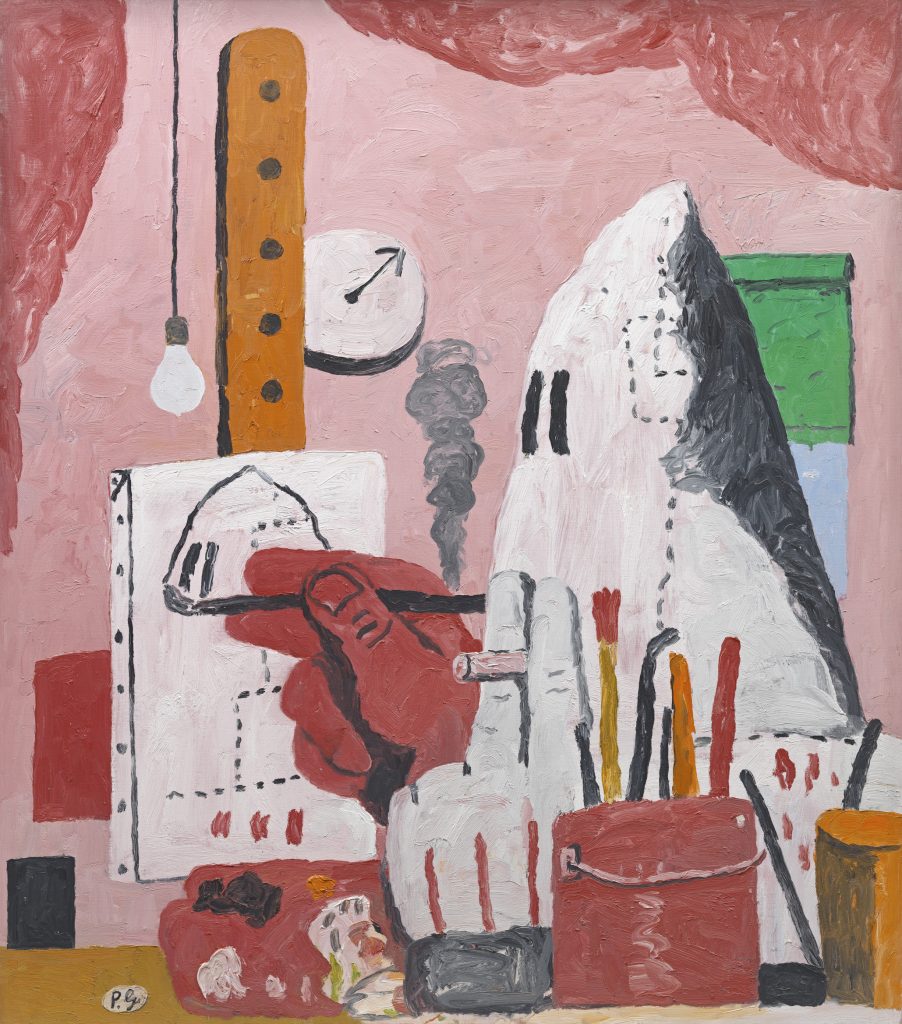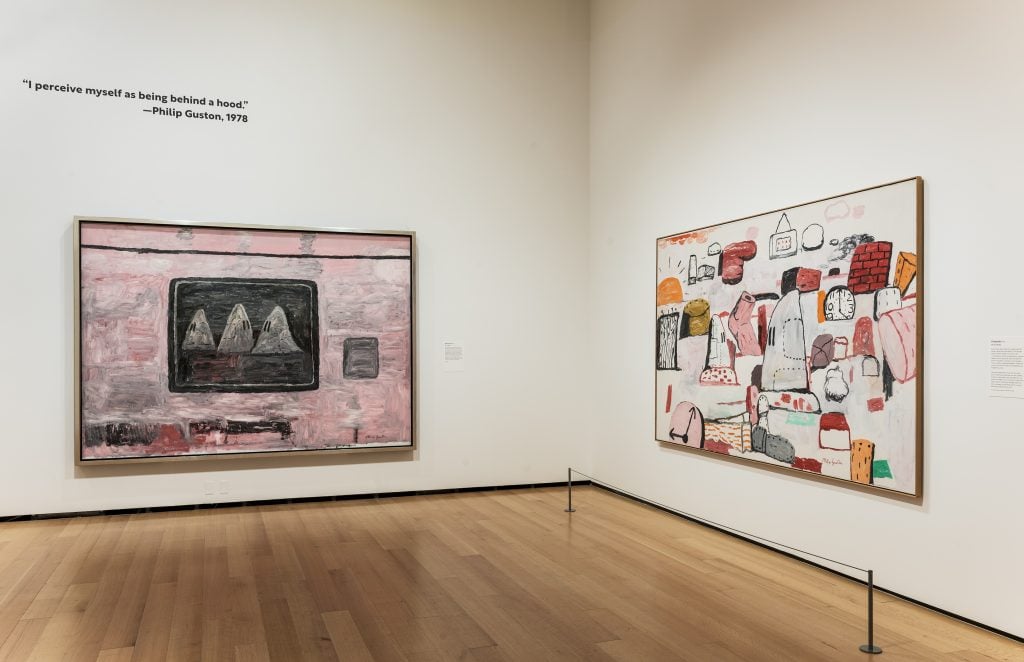The next excerpt is from the ebook Censored Artwork Immediately by Gareth Harris, revealed earlier this 12 months by Lund Humphries.
The saga of the Philip Guston exhibition, “Philip Guston Now,” that was postponed in late 2020 demonstrates how museums now endure from an identification disaster, torn between the calls for of an engaged activist viewers and agitated inner discourse. The administrators of 4 museums—Tate in London; the Nationwide Gallery of Artwork, Washington D.C.; the Museum of Nice Arts, Boston; and the Museum of Nice Arts, Houston—stated in September 2020 that the exhibition, already delayed as a result of pandemic, could be postponed “till a time at which we expect that the highly effective message of social and racial justice that’s on the heart of Philip Guston’s work may be extra clearly interpreted.” The problem, in different phrases, was certainly one of contextualization, particularly within the wake of Black Lives Matter protests held worldwide after the loss of life of George Floyd in Might 2020. However greater than 2,600 arts professionals vehemently disagreed, accusing the organizers of self-censorship (an open letter admonishing the 4 establishments was initiated by the critic Barry Schwabsky and signed by artists and students resembling Matthew Barney and Catherine de Zegher).
The groups behind the Guston present underscored that their resolution to postpone was justified within the early days of a worldwide pandemic and the emergence of the racial justice motion within the U.S. within the aftermath of Floyd’s homicide. The Guston present had been years within the planning, with round 125 work and 70 drawings loaned by 40 non-public and public collections. Although it was not referred to explicitly within the statement issued by the collaborating museums, it seems that Guston’s work and drawings that includes hooded figures evoking the Ku Klux Klan have been the problem. Guston’s pictures of Klansmen first appeared within the early Nineteen Thirties and have been prompted later by the civil unrest of the Nineteen Sixties, when he elucidated the motivation for creating the figures: “The thought of evil fascinated me . . . I virtually tried to think about that I used to be dwelling with the Klan. What would it not be prefer to be evil?” The artist was clearly additionally making an attempt to know racist ideologies in a wider sense, with some critics alluding to Guston’s try and masks his Jewish identification. Mark Godfrey, the previous Tate curator who was attributable to manage the London leg of “Philip Guston Now,” examines Guston’s Jewish ethnicity in depth within the exhibition catalogue, exploring how we expect “of the connection between image-making and Jewishness in his artwork.” ({The catalogue} was revealed regardless of the postponement of the present.)

The Studio, Philip Guston, 1969. © The Property of Philip Guston, courtesy Hauser and Wirth and the Museum of Nice Arts, Boston.
What is absolutely at play right here is whether or not museum administrators, as arbiters of morality and style, needs to be casting such judgements on the intentions of an artist and the assumed sensitivities of latest audiences. The problem is whether or not the museums concerned displayed an applicable diploma of sensitivity—or, alternately, cowardice within the eyes of detractors who leveled prices of self-censorship on the host establishments. Allow us to unpack how we obtained right here and whether or not these accusations are legitimate. A criticism leveled on the 4 venues is that they didn’t interact sufficient with native communities and have been subsequently caught unawares when the delicate materials enflamed minority voices.
Kathy Halbreich, the manager director of the New York-based Robert Rauschenberg Basis, offers a forthright evaluation of why the museums concerned have been, she believes, startlingly short-sighted of their outreach and community engagement. “I’d like to have seen the missions that animated these museums previous to this debacle. I ponder if any even flirted with the truth that fairness requires every day, holistic work,” she says. “The unhappy factor is that if an institutional mission doesn’t acknowledge and embrace these sensitivities, the group will possible react inappropriately on the final second. Belief must be constructed over time together with a deeper understanding of bias and an knowledgeable method to talk about these items,” Halbreich feedback.
Looming over this fallout is the essential malaise that America’s racism is deep, broad, and generations outdated, says the critic and scholar Robert Storr, who’s scathing about what he sees as the dearth of foresight concerned within the resolution. Guston was difficult white liberalism, Storr says, and was mainly asserting that every one white individuals may be Klansmen and that anyone in white society may very well be complicit with the crime of white supremacism. “It’s a must to actually dig deep and do some artwork historical past and a few group outreach. Establishments can’t abruptly put black artwork in all places to show that they’re sympathetic once they’ve been unsympathetic for years,” he opines.

“Philip Guston Now” exhibition on the Museum of Nice Arts, Boston.
{Photograph} © Museum of Nice Arts, Boston.
Kaywin Feldman, the director of the Nationwide Gallery of Artwork (NGA), Washington D.C., defends the Guston resolution. She reiterates that her workforce is participating with completely different communities to debate how the gallery can discover Guston’s issues about racism in addition to the opposite points his works study, resembling antisemitism, migration, poverty, and suicide. A cross-departmental workforce on the gallery has collaborated with the non-profit community Worldwide Coalition of Websites of Conscience to additional group engagement. She says that the gallery has hung out deepening relationships with a lot of its front-line employees who’ve generally felt “marginalized and invisible previously.” Change additionally begins on the high, she says. “I’m happy to notice that since 2019 our board of trustees and management workforce have grown extra numerous and reflective of the nation, at 40 % and 60 % Black, Indigenous individuals of colour respectively.” The exhibition was delayed and by no means cancelled, she stresses, emphasizing that with the broader cultural conversations about “being cancelled,” many conflated the choice to postpone with a cancellation when that was by no means the case. That is endorsed by Matthew Teitelbaum, the director of the Museum of Nice Arts, Boston, who says that the undertaking will probably be extra considerate, particular, and nuanced after the delay. “Of the exhibition we heard ‘cancellation,’ which was by no means contemplated. We heard ‘censorship—I’d argue the other. And we heard ‘lack of braveness’—I’d argue the other.” He turns the censorship argument round, articulating how the choice to delay can solely be a very good factor. “If cancel tradition is expressed, theoretically, as an vital device of social justice, what may very well be extra enlightened in response to such a method than presenting a extra rounded model of an artist’s body of reference? Actually participating with an artist’s contextual content and private historical past, an expression of values?” However critics will probably be eager to see if the context “to interpret the highly effective message of social and racial justice that’s on the heart of Philip Guston’s work”—as the museums’ joint assertion described it—[would] be the best one. J.S. Marcus has reported that the revised Boston present contains 73 work and 27 drawings whereas the NGA leg encompasses 250 Guston works. Of the unique 15 Klans-related works deliberate for Boston, 5 have been eliminated, although this resolution was attributable to “area causes,” says the MFA.
In the meantime, not one of the sponsors pulled out, says a spokeslady for the NGA (these embrace the Carl and Ruth Shapiro Household Basis and the Terra Basis for American Artwork); one other sponsor, the Ford Basis in New York, vocalized help for the postponement. It’s noteworthy that Darren Walker, the president of the Ford Basis and Trustee of the NGA, was adamant that “the context within the U.S. has basically, profoundly modified on problems with incendiary and poisonous racial imagery in artwork.” Can museums afford to offend their sponsors? Museums are apt to self-censor, treading rigorously round delicate matters, says Maxwell Anderson, the previous director of Dallas Museum of Artwork. “They’re unlikely to pursue or acquire sponsors for exhibitions that will appeal to controversy. For essentially the most half sponsors don’t immediately affect institutional selections however they accomplish that not directly by being successfully off-limits in the case of doubtlessly polarizing materials or themes.”
Gareth Harris is chief contributing editor on the Artwork Newspaper.
Observe Artnet News on Fb:
Want to stay ahead of the art world? Subscribe to our newsletter to get the breaking news, eye-opening interviews, and incisive critical takes that drive the conversation forward.


